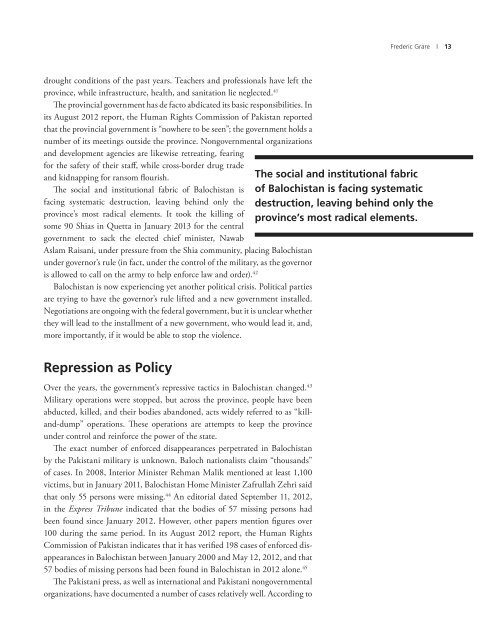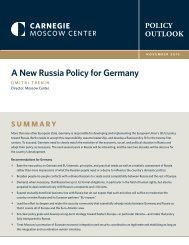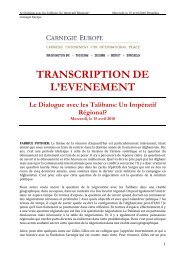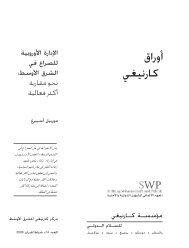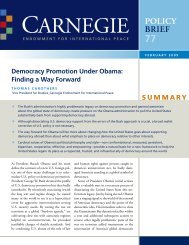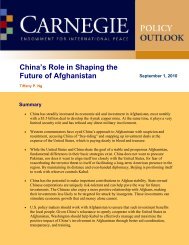BALOCHISTAN - Carnegie Endowment for International Peace
BALOCHISTAN - Carnegie Endowment for International Peace
BALOCHISTAN - Carnegie Endowment for International Peace
You also want an ePaper? Increase the reach of your titles
YUMPU automatically turns print PDFs into web optimized ePapers that Google loves.
Frederic Grare | 13<br />
drought conditions of the past years. Teachers and professionals have left the<br />
province, while infrastructure, health, and sanitation lie neglected.<br />
The social and institutional fabric<br />
of Balochistan is facing systematic<br />
destruction, leaving behind only the<br />
province’s most radical elements.<br />
41<br />
The provincial government has de facto abdicated its basic responsibilities. In<br />
its August 2012 report, the Human Rights Commission of Pakistan reported<br />
that the provincial government is “nowhere to be seen”; the government holds a<br />
number of its meetings outside the province. Nongovernmental organizations<br />
and development agencies are likewise retreating, fearing<br />
<strong>for</strong> the safety of their staff, while cross-border drug trade<br />
and kidnapping <strong>for</strong> ransom flourish.<br />
The social and institutional fabric of Balochistan is<br />
facing systematic destruction, leaving behind only the<br />
province’s most radical elements. It took the killing of<br />
some 90 Shias in Quetta in January 2013 <strong>for</strong> the central<br />
government to sack the elected chief minister, Nawab<br />
Aslam Raisani, under pressure from the Shia community, placing Balochistan<br />
under governor’s rule (in fact, under the control of the military, as the governor<br />
is allowed to call on the army to help en<strong>for</strong>ce law and order). 42<br />
Balochistan is now experiencing yet another political crisis. Political parties<br />
are trying to have the governor’s rule lifted and a new government installed.<br />
Negotiations are ongoing with the federal government, but it is unclear whether<br />
they will lead to the installment of a new government, who would lead it, and,<br />
more importantly, if it would be able to stop the violence.<br />
Repression as Policy<br />
Over the years, the government’s repressive tactics in Balochistan changed. 43<br />
Military operations were stopped, but across the province, people have been<br />
abducted, killed, and their bodies abandoned, acts widely referred to as “killand-dump”<br />
operations. These operations are attempts to keep the province<br />
under control and rein<strong>for</strong>ce the power of the state.<br />
The exact number of en<strong>for</strong>ced disappearances perpetrated in Balochistan<br />
by the Pakistani military is unknown. Baloch nationalists claim “thousands”<br />
of cases. In 2008, Interior Minister Rehman Malik mentioned at least 1,100<br />
victims, but in January 2011, Balochistan Home Minister Zafrullah Zehri said<br />
that only 55 persons were missing. 44 An editorial dated September 11, 2012,<br />
in the Express Tribune indicated that the bodies of 57 missing persons had<br />
been found since January 2012. However, other papers mention figures over<br />
100 during the same period. In its August 2012 report, the Human Rights<br />
Commission of Pakistan indicates that it has verified 198 cases of en<strong>for</strong>ced disappearances<br />
in Balochistan between January 2000 and May 12, 2012, and that<br />
57 bodies of missing persons had been found in Balochistan in 2012 alone. 45<br />
The Pakistani press, as well as international and Pakistani nongovernmental<br />
organizations, have documented a number of cases relatively well. According to


